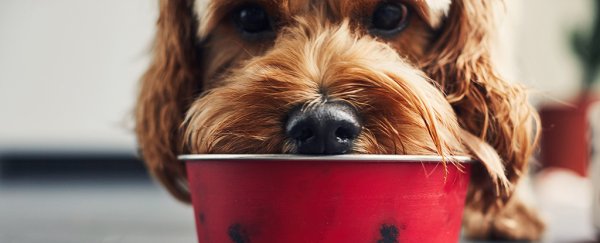A new study has found that only a small fraction of dog owners are aware of the official guidelines for safely handling their pet's food – in this case the guidelines set by the Food and Drug Administration (FDA) in the US.
These guidelines cover how pet food should be stored and served, how food bowls should be cleaned and maintained, and how to report problems with food and treats. The problem is, not enough people are aware of these simple tips to help avoid pets and owners from getting sick.
That's not just the responsibility of dog owners but also of the FDA, the researchers say: they're calling for these guidelines to be more widely publicized, and to be followed up with some rigorous scientific research to demonstrate their benefits.
"Pet feeding involves interplay between the pet, the owner, and the food," writes the team from North Carolina State University.
"This interaction creates the opportunity for mutual exchange of microbial contaminants from food or water, dishes, and the food storage or preparation environment, which can cause health consequences for both humans and pets."
The research involved surveys of 417 dog owners and swabs on 68 dog food dishes. Less than 5 percent of respondents knew that there were any guidelines to follow; when told that such guidelines existed, only 8 percent knew that the FDA website was the place to go in order to find them.
On the positive side, several of the official guidelines were widely followed by the survey group: 86 percent check their dog food for visible damage, and 91 percent know not to use the dog bowl as a scooping utensil. Almost all (97 percent) of the dog owners reported that they didn't feed their pooches raw food.
Other FDA recommendations are less well followed. The researchers found that only 12 percent of dog owners wash their pets' bowls every day, and only 22 percent wash their hands with soap and hot water before handling pet food. A mere 13 percent clean the food-scooping utensil with soap and hot water after it's been used.
As the researchers point out, we tend to overestimate how hygienic we are, and some of that bias could be present in this study too. In summary, based on this sample, dog owners could be doing a lot more to minimize bacterial build up and the risk of infection.
"Exposure to contaminated dog food can have implications for canine and human health," write the researchers. "For example, there have been multiple outbreaks of both humans and dogs becoming ill after exposure to dog food contaminated with pathogenic bacteria.
"These risks may be amplified in households with children and/or immunocompromised individuals, which were over a third of respondents' households."
The team also measured the differences that enforcing the FDA guidelines made, reporting "significant decreases" in contamination on the bowls. However, only 8 percent of those involved in the study said they would keep up with all of the protocols in the long term.
Previous research suggests that pet food dishes are common among household surfaces that are contaminated with bacteria; the spread of drug-resistant E. coli bacteria is just one of the problems that can develop as a result.
While this research used a relatively small sample size and didn't go into too much detail in terms of bacterial analysis, it's clear that more could be done by both dog owners and health bodies to make sure both pets and humans are kept as safe as possible.
"Future studies should further examine contamination with specific pathogenic bacterial species and consider the contamination risk of other microbiological agents or toxins," write the researchers.
The research has been published in PLOS One.
